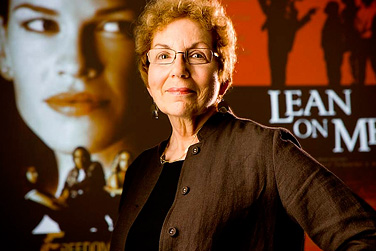News
Teachers thrive in challenging settings, researcher says

Catherine Cornbleth has studied the unique characteristics that make teachers successful in challenging classroom situations. Photo: Douglas Levere
-
 Print
Print -
 Comments
Comments
-
“Not enough teachers seem to have the know-how or willingness to teach against the grain, even when their students benefit.”
-
Related stories
Hollywood mavericks: A tradition of eccentric, successful teachers
American pop culture holds a special place for Hollywood depictions of eccentric or inexperienced teachers who use unconventional methods to achieve classroom breakthroughs and transform the lives of their students.
While these big-screen portrayals often border on the fantastical, some of the qualities exhibited by movie teachers do lead to classroom successes, according to a UB professor who studies real-life “maverick” teachers and new teachers who succeed in urban classrooms.
“What connects the experiences of these two types of teachers—the more-experienced maverick teacher and the less-experienced, successful teacher in the urban setting—is how they react to less-than-ideal or unsupportive circumstances: They simply don’t give in or give up,” says Catherine Cornbleth, a professor of learning and instruction in the Graduate School of Education.
Cornbleth has done extensive fieldwork on teachers who some might consider eccentric, who went “against the grain” or who displayed unusual methods. These maverick teachers stood out from the norm but got results in test scores, were admired by students and their peers, and found satisfaction in teaching.
In her new book, “Diversity and the New Teacher: Learning from Experience in Urban Schools” (Teachers College Press, 2008), Cornbleth examines the experiences of new elementary and secondary teachers entering unfamiliar classroom environments in urban areas. These teachers were in classrooms with students with different racial, ethnic, cultural and socio-economic backgrounds, as well as varying degrees of academic ability or motivation.
In doing fieldwork for her book, Cornbleth found that the qualities of teachers who thrived in these challenging situations were remarkably similar to the qualities of maverick teachers.
“I was intrigued by how these teachers were able to succeed under circumstances most people would find challenging or demoralizing, and in which others would struggle or give up altogether,” she says.
Cornbleth has identified the most important qualities contributing to the success of maverick teachers and young teachers in an urban setting:
- Viewing problems and obstacles as challenges, not brick walls. “They were amazing problem-solvers and trouble-shooters,” Cornbleth says, “whether it meant scavenging teaching materials or finding a way to reach a resistant student.”
- Connecting with students’ experiences. Cornbleth said the unconventional but successful teachers established relationships with students that went beyond talking to them about what music they liked or what TV shows they watched. “These teachers find a way to connect academic topics to the students’ lives and experiences,” Cornbleth says.
- Being proactive, savvy and resourceful. Cornbleth uses the example of two English teachers, one urban and one suburban, who organized a student exchange where students were paired off, visited each other’s school and followed their partner’s schedule. It shattered stereotypes on both sides. “One teacher said, ‘If I can do something to help the kids and make the principal look good, he’s not going to say no. And if we all look good, the next time I want to do something a little bit different, he won’t say no to me because I established my credibility.’”
- Demonstrating respect and caring for students, a sense of commitment and a sense of humor. “Teachers who do this gain respect in the classroom,” explains Cornbleth, “and because they show respect to the students, it’s reciprocal. They don’t demand respect. They show respect. It was one of the qualities that define these teachers.”
- Reworking, reorganizing or rearranging subject matter to make it more accessible and meaningful to students, who then do better on exams. One maverick science teacher Cornbleth studied reorganized the state curriculum in ways that made it more appealing to her students. For example, she created CSI lab activities that combined microscopic work, careful observation and hypothesizing with human hair and DNA analysis.
- Persisting and taking risks. The best teachers often are able to use personal connections they established with students to demand more from them academically. “They used the person-to-person relationship to push them. They could say, ‘C’mon, Janine. Don’t con me. Let’s go. Do it!’”
Cornbleth says she initially was attracted to the maverick teacher model because of concerns that the emphasis on standardized test scores and curricula would pressure teachers to conform to an “average” that didn’t serve most students very well.
“Doesn’t it sound like every teacher should be a bit of a maverick?” she asks. “It’s not rocket science. But not enough teachers seem to have the know-how or willingness to teach against the grain, even when their students benefit.”


Reader Comments